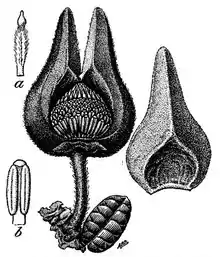Annona cascarilloides
Annona cascarilloides is a species of plant in the Annonaceae family. It is endemic to Cuba.[1] According to William Edwin Safford,[2] the species was named it after the pattern of its leaf veins which resemble species of a different genus, that at the time Safford was writing was called Cascarilla, but is now synonymous with the genera Croton[3] and Ladenbergia.[4] Despite this assertion by Safford, August Grisebach, the German botanist who first formally described the species, makes no mention of Cascarilla in his 1866 entry.[5]
| Annona cascarilloides | |
|---|---|
 | |
| Botanical illustration of Annona cascarilloides flower | |
| Scientific classification | |
| Kingdom: | Plantae |
| Clade: | Tracheophytes |
| Clade: | Angiosperms |
| Clade: | Magnoliids |
| Order: | Magnoliales |
| Family: | Annonaceae |
| Genus: | Annona |
| Species: | A. cascarilloides |
| Binomial name | |
| Annona cascarilloides | |
| Synonyms | |
|
Annona elliptica R.E.Fr. | |
Description
It is bush reaching 2 meters in height. Its leaves are 2.5-3.7 by 0.6-0.8 centimeters. The tips of the leaves end abruptly in a small point. The leaf margins are rolled under. The mature leaves are hairless on their upper and lower surfaces. The leaves have 13-15 secondary veins that branch from the midrib at near 90° angles and fork before terminating. Its inflorescences consist of solitary flowers on peduncles that are 5-7 millimeters long. Its sepals are united at their base to form a calyx with 3 triangular lobes that are 2.4 by 2.4 millimeters and covered in rust-colored hairs on their outer surface. It has two rows of petals. Its thick, oval outer petals are 6-7 by 12-20 millimeters, have a long tapering point and are hollowed at their base. The outer petals are fine rust-colored hair on their outer surface and are hairless on their inner surface. Its flowers have numerous stamens that are 1.6 millimeters long. Its flowers have numerous 1.6 millimeter long carpels that are crowded together for form a cone. Its ovaries are covered with pale red hairs and are capped by tapering, fleshy styles. Its round, hairless fruit are 3-3.5 centimeters in diameter and have thin skins and soft pulpy flesh. Its brown, shiny, oblong, wrinkly seeds are 8 by 12-16 millimeters and have a think shell.[5][2]
Reproductive biology
The pollen of Annona cascarilloides is shed as permanent tetrads.[6]
Distribution and habitat
Grows on the western side of the island and flowers in June.[2]
References
- "Annona cascarilloides Griseb". Plants of the World Online. The Trustees of the Royal Botanic Gardens, Kew. n.d. Retrieved December 24, 2018.
- Safford, William E. (1914). "Classification of the Genus Annona with Descriptions of New and Imperfectly Known Species". Contributions from the United States National Herbarium. 18: 1–68.
- "Cascarilla Adans". Plants of the World Online. The Trustees of the Royal Botanic Gardens, Kew. n.d. Retrieved June 21, 2019.
- "Cascarilla (Endl.) Wedd". Plants of the World Online. The Trustees of the Royal Botanic Gardens, Kew. n.d. Retrieved June 21, 2019.
- Grisebach, August (1866). Catalogus plantarum cubensium exhibens collectionem Wrightianam aliasque minores ex insula Cuba missas (in Latin). Apud Gulielmum Engelmann. pp. 2. doi:10.5962/bhl.title.177.
- Walker, James W. (1971). "Pollen Morphology, Phytogeography, and Phylogeny of the Annonaceae". Contributions from the Gray Herbarium of Harvard University. 202: 1–130. JSTOR 41764703.